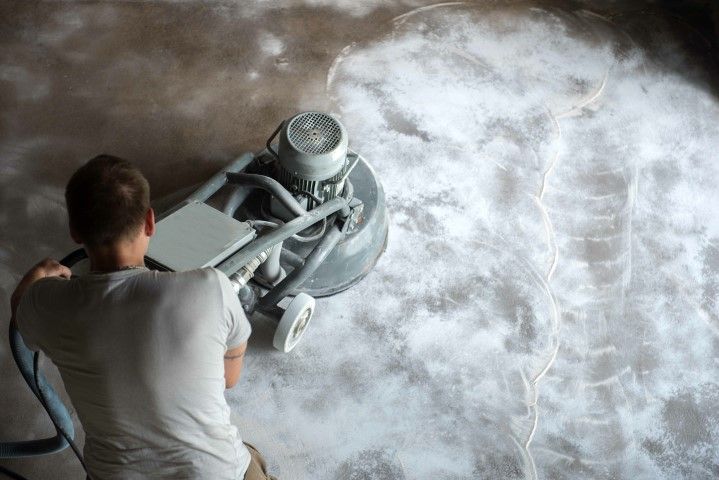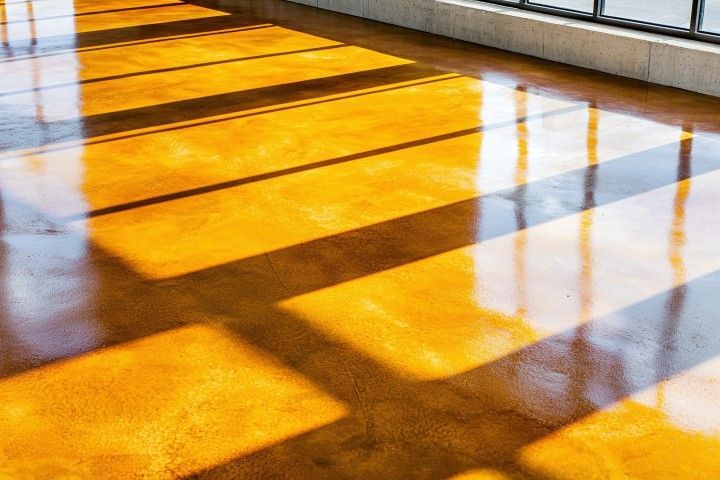Culver City Epoxy Flooring Pros
424-842-4773
Get Your Free Quote Today
************
Concrete Polishing and Staining in Culver City CA
************
When you think about improving the air you breathe inside your home or business, you might picture air purifiers or opening windows. But there is another effective way that often gets overlooked—concrete polishing and staining. More people are choosing polished and stained concrete surfaces not only for their beauty but also because they can help create cleaner, healthier indoor spaces. Below are four ways concrete polishing and staining in Culver City, CA can improve indoor air quality:
Reduces Dust and Allergens
Unfinished concrete floors naturally shed tiny dust particles over time. These fine particles can float into the air, settle on surfaces, and get stirred up as you walk around. This dust can irritate allergies or breathing conditions. Polishing and staining the concrete seals the surface so it becomes smooth and dense, stopping dust from forming and spreading. As a result, you enjoy cleaner air and less need for constant dusting and sweeping.
Limits Mold and Bacteria Growth
Concrete can absorb moisture, which creates the perfect environment for mold and bacteria to grow. Once mold starts spreading, it releases spores into the air that can trigger respiratory problems, headaches, or skin irritation. Polished and stained concrete is sealed so moisture cannot seep in as easily. This protective layer reduces the chances of mold taking hold. By keeping your floors dry and less porous, you lower the risk of mold-related air problems.
Reduces Use of Harsh Cleaning Chemicals
Some flooring materials require strong cleaners to remove stains, dirt, or buildup. These cleaning products often leave behind chemical fumes and residues that linger in the air. Polished and stained concrete floors are much easier to clean with gentle, eco-friendly products like water and mild soap. Because they resist stains and do not trap dirt, you can maintain them without heavy chemicals. This helps keep indoor air safer for everyone, including children and pets.
Creates a Non-Toxic Finish
When installed by professionals, polished and stained concrete uses water-based dyes and sealers with low or no volatile organic compounds (VOCs). VOCs are chemicals that evaporate into the air and can cause eye, nose, or throat irritation. Traditional flooring choices like carpet or some epoxy flooring options can release VOCs during installation and over time. Choosing low-VOC concrete finishes means you can enjoy the look you want without worrying about breathing in harmful fumes.
Concrete polishing and staining also blend well with other modern design features. Whether you prefer a sleek industrial style or a warmer look with rich stain colors, these floors complement many spaces. Some property owners even pair polished concrete with epoxy flooring in garages or workshops, combining durability with attractive finishes.
If you’d like to learn more about how concrete polishing and staining can make your indoor spaces cleaner and healthier, our team is ready to help. We can answer your questions, explain the process in simple terms, and offer a free estimate. Reach out today and discover how polished concrete can transform your floors and improve the air you breathe.
Choosing the Right Grit Levels for Concrete Polishing
************
Concrete polishing is a great way to improve the look and feel of your floors. Whether you own a home, store, or warehouse, polished concrete can provide a clean, attractive surface that lasts for years. But one of the most important parts of the polishing process is choosing the right grit levels. Using the proper grit makes all the difference in the smoothness, shine, and durability of the final floor.
When polishing concrete, grit refers to the size of the abrasive particles on the polishing pads. Lower grit numbers have larger particles that remove more material. Higher grit numbers are finer and create a smoother finish. Picking the right sequence of grits helps you reach the level of shine you want while also protecting the floor.

Start with a Lower Grit
If your concrete floor is rough, stained, or has old coatings, you will need to start with a low grit, such as 30 or 50. This step helps remove any surface imperfections, like scratches, glue, or paint. The lower grit cuts away the top layer and evens out the surface. It is a vital step because any flaws left behind can affect the look of the finished floor. Make sure to clean the floor between passes to get rid of dust and debris.
Move to Medium Grit
After the first cut, you should move up to a medium grit, usually between 80 and 150. Medium grits help remove the rough scratches left by the lower grit pads. They also begin to close up the concrete pores, making the surface denser and more prepared for the final polishing steps. This part of the process also helps the floor start to show a slight sheen, which will become clearer later on.
Finish with High Grit
The higher grits, such as 200, 400, and even up to 1500 or 3000, are used to bring out the shine and smoothness. Each step refines the floor further, creating a glossy, mirror-like surface if desired. For most commercial spaces, polishing up to 800 grit is common because it gives a balanced look without being too slippery. Higher grits can be used when a high-gloss finish is the goal, such as in showrooms or upscale offices.
Sealing and Protecting
Once you have polished the concrete to the desired level, applying a sealer or densifier helps protect it from stains, moisture, and wear. While concrete polishing is different from epoxy flooring, the two can sometimes be used together if you want a colored or decorative surface with extra protection. Sealed polished concrete is easier to clean and maintain, reducing the need for constant upkeep.
Choosing the right grit levels for concrete polishing can seem tricky, but you don’t have to do it alone. Our team has years of experience working with different floor types, from plain concrete to epoxy flooring. We know how to pick the correct tools and techniques to get the best results for your space. If you have questions or would like a free quote, please reach out today. We are here to help you transform your concrete floors into a surface you will be proud to show off.
Pros and Cons of Water-Based vs. Solvent-Based Concrete Stains
************
When you want to improve the look of concrete surfaces, you have many options. Two of the most popular choices are water-based and solvent-based concrete stains. Each has unique strengths and weaknesses. Understanding their differences will help you decide which type suits your project best, whether you are finishing a garage, patio, or even planning to use epoxy flooring later on.

Color Variety and Appearance
Water-based stains offer a wide range of bright, consistent colors. You can pick almost any shade to match your style. They work well if you want a uniform look across the floor. Solvent-based stains, on the other hand, produce richer, deeper tones. These stains often bring out the natural character and small flaws in the concrete, giving it a mottled, more traditional finish. If you like the idea of a natural stone look, solvent-based options may appeal to you more.
Ease of Use and Cleanup
One big advantage of water-based stains is how easy they are to apply and clean. You can use simple tools like a sprayer or roller, and cleanup requires only soap and water. They dry faster, which can save time if you have a tight schedule. Solvent-based stains need more care when applying because they release strong fumes. You also need special chemicals like acetone or mineral spirits to clean tools and spills. This makes them a bit harder for beginners to work with safely.
Durability and Performance
Solvent-based stains generally penetrate concrete better, so the color lasts longer and resists fading from sunlight or heavy foot traffic. This can be important if the surface will be exposed to harsh weather or daily use. Water-based stains may not soak in as deeply, which sometimes leads to a less durable finish over time. However, when sealed properly, both types can last many years and hold up to normal wear and tear.
Safety and Environmental Impact
Many homeowners prefer water-based stains because they have low odor and release fewer harmful chemicals into the air. This makes them safer to use indoors and better for the environment. Solvent-based stains produce more fumes and require good ventilation. You should wear protective gear, including a respirator, when applying them. For people sensitive to strong smells or chemicals, water-based products can be a healthier choice.
Choosing between water-based and solvent-based stains depends on your priorities. If you want bright, consistent color with simple cleanup, water-based is likely the best fit. If you prefer deep, rich tones with excellent durability, solvent-based may be worth the extra effort. Our team is here to help you find the right solution for your space, whether you plan to install urethane cement, stain your concrete or install epoxy flooring for a polished finish. Reach out to us today to discuss your project goals and get expert advice. Together, we can create a surface that looks great and stands the test of time.